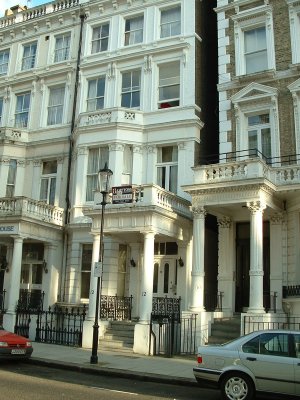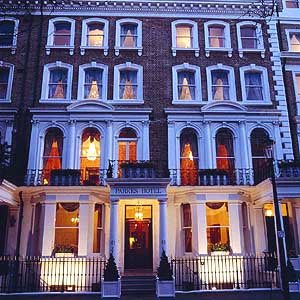A the time of his death they were living at 12 Lexham Gardens in Kensington, London


b. 12 Jan.1810, co. Limerick, 7th son of STANDISH O'GRADY, 1st VISCOUNT GUILLAMORE of CAHIR GUILLAMORE, co. Limerick, and BARON O'GRADY of ROCKBARTON. Served in the 15th Foot and then the 74th Highlanders ;
""| 30 | Dec. | 1826 | , Ensign 15th Foot. | ||
| 24 | ???. | 1829 | , Lieut. 15th Foot. | ||
| 3 | Dec. | 1829 | , Lieut. 74th High. | ||
| 3 | Oct. | 1834 | , Captain 74th High. | ||
| 12 | May | 1839 | , Embarked for Tobago. 1 Capt., 1 Lieut., 4 Sgt's, 1 Drummer, 94 Rank. | ||
| 14 | Jun. | 1840 | to 30 Apr. 1841, Leave of absence. | ||
| 3 | Oct. | 1841 | to 2 Jul. 1843, North America. | ||
| 10 | Jul. | 1846 | , Major 74th High., by purchase. |
The following is an extract from http://www.electricscotland.com/history/scotreg/74th-1.htm detailing the history of the 74th Highlanders around the time of Thomas's commission:-
The regiment remained in Ireland till May 1818, not having had a chance of distinguishing itself at the crowning victory of Waterloo, although it was on its way to embark for Belgium when news of that decisive battle arrived. While at Fermoy, on the 6th of April 1818, the regiment was presented with new colours. The colours which had waved over the regiment in many a hard-fought field, and which had been received in 1802, were burned, and the ashes deposited in the lid of a gold sarcophagus snuff-box, inlaid with part of the wood of the colour-staves, on which the following inscription was engraved:—"This box, composed of the old standards of the Seventy-fourth regiment, was formed as a tribute of respect to the memory of those who fell, and of esteem for those who survived the many glorious and arduous services on which they were always victoriously carried, during a period of sixteen years, in India, the Peninsula, and France. They were presented to the regiment at Wallajahbad in 1802, and the shattered remains were burned at Fermoy on the 6th of April 1818."
The 74th embarked at Cork for Halifax, Nova Scotia, on the 13th of May, leaving one depôt company, which was sent to the Isle of Wight. The companies were divided between St John’s, Newfoundland, St John’s, New Brunswick, and Frederickton, where were headquarters and five companies. The regiment remained in North America till 1828, in August of which year proceeding to Bermudas, which it left at the end of the next year for lreland, where it arrived in the beginning of 1830. In 1818 the regiment had been reduced to ten companies of 65 rank and file each, and in 1821 it was further reduced to eight companies of 72 rank and file. In 1825, however, the strength was augmented to ten companies—six service companies of 86 rank and file, and four depot companies of 56 rank and file each.
The regiment remained in Ireland till 1834, during part of which time it was actively employed in suppressing the outrages consequent on the disturbed state of the country. In the latter part of 1834 the regiment was divided into four depot and six service companies; three of the latter were sent to Barbadoes, while the headquarter division, consisting of the three remaining companies, was sent to the island of Grenada. In November 1835 the two service divisions were sent to Antigua, where they remained till February 1837. From thence the headquarter division proceeded to St Lucia, and the other three companies to Demerara, both divisions being sent to St Vincent in June of the same year. The regiment was kept moving about among these western islands till May 1841, when it proceeded to Canada, arriving at Quebec at the end of the month. While the regiment was stationed at Trinidad it was attacked by fever and dysentery, which caused great mortality; and fever continued to prevail among the men until the regiment removed to Trinidad. With this exception the 74th remained remarkably healthy during the whole of its residence in the West Indies.
The 74th remained in the North American colonies till 1845, being removed from Canada to Nova Scotia in May 1844, and embarking at Halifax for England in March 1845. On arriving in England in the end of that month, the service companies joined the depot at Canterbury.
While the regiment was stationed in Canterbury, Lieutenant-Colonel Crabbe, commanding the regiment, submitted to the Commander-in-Chief, through the colonel (Lieutenant-General Sir Phineas Ryall), the earnest desire of the officers and men to be permitted to resume the national garb and designation of a Highland regiment, under which the 74th had been originally embodied.
The lieutenant-colonel having himself first joined the regiment as a Highland corps in the year 1807, and having served with it continuously during the intervening period, knew by his own experience, and was able to certify to the Commander-in-Chief, how powerfully and favourably its character had been influenced by its original organisation; and also that throughout the varied services and changes of so many years, a strong national feeling, and a connection with Scotland by recruiting, had been constantly maintained. Various considerations, however, induced an application for permission to modify the original dress of kilt and feathered bonnet, and with the resumed designation of a Highland corps, to adopt the trews and bonnet as established for the 71st regiment.
His Grace the Duke of Wellington was pleased to return a favourable answer to the application, in such terms as to render his consent doubly acceptable to the corps, causing it to be intimated to the colonel, by a letter from the adjutant-general, bearing date ‘Horse Guards, 13th August 1845,’ that he would recommend to Her Majesty that the 74th Regiment should be permitted to resume the appellation of a Highland regiment, and to be clothed "accordingly in compliment to the services of that regiment so well known to his Grace in India and in Europe."
In the "Gazette" of the 14th November 1845 the following announcement was published:—
"WAR Office, 8th November 1845.
"Memorandum,—Her Majesty has been graciously pleased to approve of the 74th foot resuming the appellation of the 74th (Highland) Regiment of foot, and of its being clothed accordingly; that is, to wear the tartan trews instead of the Oxford mixture; plaid cap instead of the black chaco; and the plaid scarf as worn by the 71st Regiment. The alteration of the dress is to take place on the next issue of clothing, on the 1st of April 1846."
The national designation of the regiment was of course immediately resumed, and the recruiting has been since carried on solely in Scotland with uniform success.
It was directed by the Adjutant-General that the tartan now to be worn by the 74th should not be of the old regimental pattern, that being already in use by two other regiments (the 42nd and 93rd), but that it should be distinguished by the introduction of a white stripe. The alteration of the regimental dress took place as ordered, on the 1st of April 1846.
In May 1846, Lieutenant-Colonel Crabbe, who had been connected with the regiment for forty years, retired on full pay, and took leave of the regiment in a feeling order. Major Crawley was promoted to the lieutenant colonelcy in his place.
Thomas married 23 Jan.1856, Maria de la Soledad-Isabel-Sofia, only daughter of Frances-Lewes Ball, Esq., secretary of legation at Buenos Ayres, and d. 22 Jan.1882. She d. 28 Feb.1889. They were buried at West Brompton Cemetery.
|
A the time of his death they were living at 12 Lexham Gardens in Kensington, London |
At the time of Maria's death in 1889, she was noted as being formerly of 12 Lexham Gardens but late of The Quarry, Penshurst, Kent, and died at 41 Beaufort Gardens, South Kensington now the Parkes hotel, below) | |
 |
|
THOMAS BALFOUR O'GRADY was born c.1839, to MARY
TAYLOR in Stirling, Scotland and stated on his
marriage certificate in 1865, age 25,that his father was the deceased Thomas O'Grady, a Major in the
74th Regiment. There is no absolute proof that the above Honorable Thomas O'Grady was
indeed his father, but it looks highly likely. It is also interesting to note the dates of his
leave of absence from duty in the West Indies above which tie in with his birth. There must also have been some contact well
after his birth as Thomas Balfour Geddes stated in his marriage
certificate of 1865 that his father was the deceased Major
Thomas O'Grady; the Hon. Thomas O'Grady was a Captain in 1839 when his illegitimate
son was born and made Major in 1846. Family folklore, from my grannie Burrell,
always said that there was "blue blood born on the wrong side of the
blanket" in this side of the family. There is also a story of a carriage
with some rich folk arriving one day at the cottage in Slamannan. Thomas
used the name GEDDES in preference to O'GRADY in the 1881 and 1891 census, but there is as
yet, no clue to why he changed his name - I wonder if this visit was to arrange
a pay-off after his father's death on the proviso that he changed his name.
Thomas married, 3 Jan 1865 at Slamannan,
MARGARET FLEMING JOHNSTON, b 1846, Slamannan, dau. of GAVIN JOHNSTON and MARGARET DUN, d. 29 Dec.1920,and had issue,
| MacGregor Chart | MacGregor Photos | Viscount O'Grady | Geddes Places |